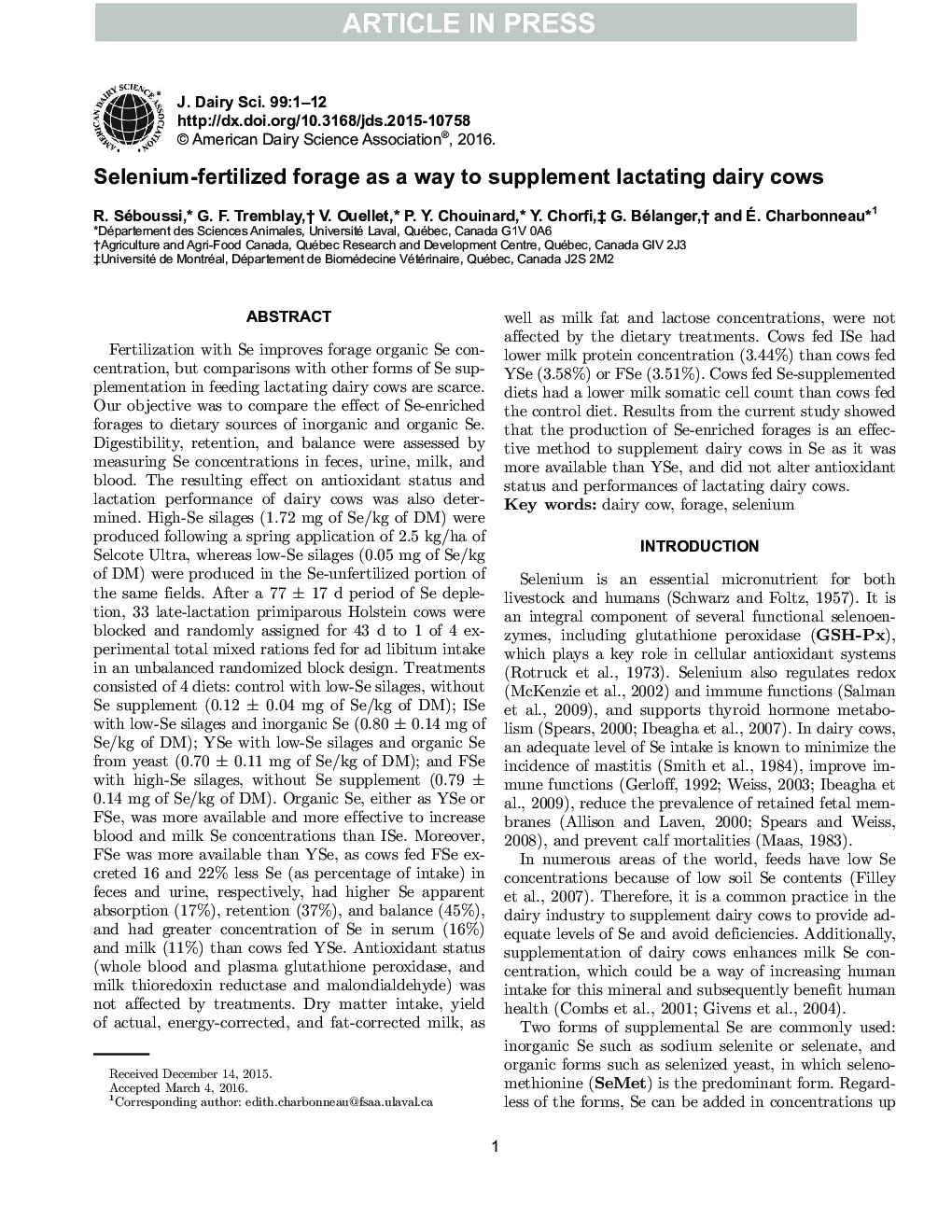| کد مقاله | کد نشریه | سال انتشار | مقاله انگلیسی | نسخه تمام متن |
|---|---|---|---|---|
| 10973633 | 1108017 | 2016 | 12 صفحه PDF | دانلود رایگان |
عنوان انگلیسی مقاله ISI
Selenium-fertilized forage as a way to supplement lactating dairy cows
ترجمه فارسی عنوان
علوفه لقاح سلنیوم به عنوان راهی برای تکمیل گاوهای شیرده
دانلود مقاله + سفارش ترجمه
دانلود مقاله ISI انگلیسی
رایگان برای ایرانیان
کلمات کلیدی
گاو شیری، علوفه، سلنیوم،
موضوعات مرتبط
علوم زیستی و بیوفناوری
علوم کشاورزی و بیولوژیک
علوم دامی و جانورشناسی
چکیده انگلیسی
Fertilization with Se improves forage organic Se concentration, but comparisons with other forms of Se supplementation in feeding lactating dairy cows are scarce. Our objective was to compare the effect of Se-enriched forages to dietary sources of inorganic and organic Se. Digestibility, retention, and balance were assessed by measuring Se concentrations in feces, urine, milk, and blood. The resulting effect on antioxidant status and lactation performance of dairy cows was also determined. High-Se silages [1.72 mg of Se/kg of dry matter (DM)] were produced following a spring application of 2.5 kg/ha of Selcote Ultra, whereas low-Se silages (0.05 mg of Se/kg of DM) were produced in the Se-unfertilized portion of the same fields. After a 77 ± 17 d period of Se depletion, 33 late-lactation primiparous Holstein cows were blocked and randomly assigned for 43 d to 1 of 4 experimental total mixed rations fed for ad libitum intake in an unbalanced randomized block design. Treatments consisted of 4 diets: control with low-Se silages, without Se supplement (0.12 ± 0.04 mg of Se/kg of DM); ISe with low-Se silages and inorganic Se (0.80 ± 0.14 mg of Se/kg of DM); YSe with low-Se silages and organic Se from yeast (0.70 ± 0.11 mg of Se/kg of DM); and FSe with high-Se silages, without Se supplement (0.79 ± 0.14 mg of Se/kg of DM). Organic Se, either as YSe or FSe, was more available and more effective to increase blood and milk Se concentrations than ISe. Moreover, FSe was more available than YSe, as cows fed FSe excreted 16 and 22% less Se (as percentage of intake) in feces and urine, respectively, had higher Se apparent absorption (17%), retention (37%), and balance (45%), and had greater concentration of Se in serum (16%) and milk (11%) than cows fed YSe. Antioxidant status (whole blood and plasma glutathione peroxidase, and milk thioredoxin reductase and malondialdehyde) was not affected by treatments. Dry matter intake, yield of actual, energy-corrected, and fat-corrected milk, as well as milk fat and lactose concentrations, were not affected by the dietary treatments. Cows fed ISe had lower milk protein concentration (3.44%) than cows fed YSe (3.58%) or FSe (3.51%). Cows fed Se-supplemented diets had a lower milk somatic cell count than cows fed the control diet. Results from the current study showed that the production of Se-enriched forages is an effective method to supplement dairy cows in Se as it was more available than YSe, and did not alter antioxidant status and performances of lactating dairy cows.
ناشر
Database: Elsevier - ScienceDirect (ساینس دایرکت)
Journal: Journal of Dairy Science - Volume 99, Issue 7, July 2016, Pages 5358-5369
Journal: Journal of Dairy Science - Volume 99, Issue 7, July 2016, Pages 5358-5369
نویسندگان
R. Séboussi, G.F. Tremblay, V. Ouellet, P.Y. Chouinard, Y. Chorfi, G. Bélanger, Ã. Charbonneau,
